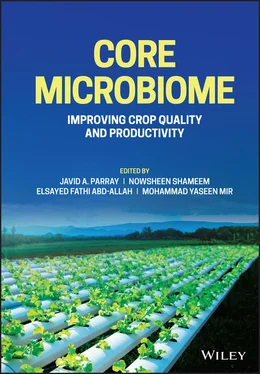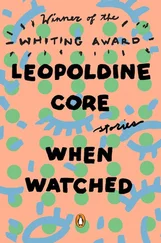41 Govindasamy, V., Senthilkumar, M., Magheshwaran, V., Kumar, U., Bose, P., Sharma, V., and Annapurna, K. (2010). Bacillus and Paenibacillus spp.: Potential PGPR for sustainable agriculture. In: Plant Growth and Health Promoting Bacteria. 333–364, Springer
42 Grainger, C.M. and Rajcan, I. (2014). Characterization of the genetic changes in a multi-generational pedigree of an elite Canadian soybean cultivar. Theoretical and Applied Genetics 127 (1): 211–229.
43 Guo, D., Chen, J., Du, X., and Han, B. (2010). Screening of molluscicidal strain against Oncomelania hupensis from the rhizosphere of medicinal plant Phytolacca acinosa Roxb. Pharmacognosy Magazine 6 (23): 159.
44 Hashem, A., Abd_Allah, E.F., Alqarawi, A.A., Radhakrishnan, R., and Kumar, A. (2017). Plant defense approach of Bacillus subtilis (BERA 71) against Macrophomina phaseolina (Tassi) Goid in mung bean. Journal of Plant Interactions 12 (1): 390–401.
45 Islam, S., Izekor, E., and Garner, J.O. (2009). Development of selection procedures of Sweetpotato genotypes according to chilling tolerance. Journal of Food, Agriculture & Environment 7 (2): 329–331.
46 Jaleel, C.A., Gopi, R., Manivannan, P., and Panneerselvam, R. (2008). Soil salinity alters the morphology in Catharanthus roseus and its effects on endogenous mineral constituents. EurAsian Journal of BioSciences 2 (1): 18–25.
47 Karami, O.R.A., Khodaverdi, M., and Ali, A.F. (2010). Antibacterial effect of effective compounds of Satureja hortensis and Thymus vulgaris essential oils against Erwinia amylovora.
48 Karthik, L., Kumar, G., Keswani, T., Bhattacharyya, A., Chandar, S.S., and Bhaskara Rao, K.V. (2014). Protease inhibitors from marine actinobacteria as a potential source for antimalarial compound. PloS One 9 (3): e90972.
49 Karthikeyan, B., Jaleel, C.A., Lakshmanan, G.M.A., and Deiveekasundaram, M. (2008). Studies on rhizosphere microbial diversity of some commercially important medicinal plants. Colloids and Surfaces B: Biointerfaces 62 (1): 143–145.
50 Kasilo, O.M.J. and Trapsida, J.-M. (2010). Regulation of traditional medicine in the WHO African region. Afr. Health Monit. (Online), 25–31.
51 Kato, T., HINoo, H.I.R.O.S.H.I., and Shoji, J.U.N.I.C.H.I. (1978). The structure of tridecaptin A studies on antibiotics from the genus Bacillus. XXIV. The Journal of Antibiotics 31 (7): 652–661.
52 Kaymak, H.C. (2010). Potential of PGPR in agricultural innovations. In: Plant Growth and Health Promoting Bacteria. 45–79.
53 Köberl, M., Schmidt, R., Ramadan, E.M., Bauer, R., and Berg, G. (2013). The microbiome of medicinal plants: Diversity and importance for plant growth, quality and health. Frontiers in Microbiology 4: 400.
54 Koocheki, A., Nassiri-Mahallati, M., and Azizi, G. (2008). Effect of drought, salinity, and defoliation on growth characteristics of some medicinal plants of Iran. Journal of Herbs, Spices & Medicinal Plants 14 (1–2): 37–53.
55 Koussevitzky, S., Suzuki, N., Huntington, S., Armijo, L., Sha, W., Cortes, D., and Mittler, R. (2008). Ascorbate peroxidase 1 plays a key role in the response of Arabidopsis thaliana to stress combination. Journal of Biological Chemistry 283 (49): 34197–34203.
56 Kulkarni, M.G., Street, R.A., and Van Staden, J. (2007). Germination and seedling growth requirements for propagation of Dioscorea dregeana (Kunth) Dur. and Schinz—A tuberous medicinal plant. South African Journal of Botany 73 (1): 131–137.
57 Kumar, A. and Dubey, A. (2020). Rhizosphere microbiome: Engineering bacterial competitiveness for enhancing crop production. Journal of Advanced Research 24: 337–352.
58 Kumar, M., Tomar, R.S., Lade, H., and Paul, D. (2016). Methylotrophic bacteria in sustainable agriculture. World Journal of Microbiology and Biotechnology 32 (7): 1–9.
59 Kumar, S., Narula, A., Sharma, M.P., and Srivastava, P.S. (2004). In vitro propagation of Pluchea lanceolata, a medicinal plant, and effect of heavy metals and different aminopurines on quercet in content. Vitro Cellular & Developmental Biology-Plant 40 (2): 171–176.
60 Kumar, P., Dubey, R.C., and Maheshwari, D.K. (2012). Bacillus strains isolated from rhizosphere showed plant growth promoting and antagonistic activity against phytopathogens. Microbiological Research 167 (8): 493–499.
61 Kumar, V., Singh, S., Singh, J., and Upadhyay, N. (2015). Potential of plant growth promoting traits by bacteria isolated from heavy metal contaminated soils. Bulletin of Environmental Contamination and Toxicology 94 (6): 807–814.
62 Kumara, P.M., Zuehlke, S., Priti, V., Ramesha, B.T., Shweta, S., Ravikanth, G., and Shaanker, R.U. (2012). Fusarium proliferatum, an endophytic fungus from Dysoxylum binectariferum Hook. f, produces rohitukine, a chromane alkaloid possessing anti-cancer activity. Antonie Van Leeuwenhoek 101 (2): 323–329.
63 Kusano, M., Tohge, T., Fukushima, A., Kobayashi, M., Hayashi, N., Otsuki, H., and Matsuda, F. (2011). Metabolomics reveals comprehensive reprogramming involving two independent metabolic responses of Arabidopsis to UV‐B light. The Plant Journal 67 (2): 354–369.
64 Laszlo, I., Szoke, E., and Tyihak, E. (1998). Relationship between abiotic stress and formaldehyde concentration in tissue culture of Datura Innoxia Mill. Plant Growth Regulation 25 (3): 195–199.
65 Li, H., Qiang, S., and Qian, Y. (2008). Physiological response of different croftonweed (Eupatorium adenophorum) populations to low temperature. Weed Science 56 (2): 196–202.
66 Ma, J., Feng, X., Yang, X., Cao, Y., Zhao, W., and Sun, L. (2020). The leaf extract of crofton weed (Eupatorium adenophorum) inhibits primary root growth by inducing cell death in maize root border cells. Plant Diversity 42 (3): 174–180.
67 Malla, B.A., Maqbool, I., Lone, S.A., Ahmad, S., Bhat, A.M., Para, I.A., and Dar, P.S. (2018). An overview on Neurocysticercosis. Journal of Pharmacognosy and Phytochemistry 7 (6): 303–312.
68 Manavalan, L.P., Guttikonda, S.K., Phan Tran, L.-S., and Nguyen, H.T. (2009). Physiological and molecular approaches to improve drought resistance in soybean. Plant and Cell Physiology 50 (7): 1260–1276.
69 Meena, K.K., Sorty, A.M., Bitla, U.M., Choudhary, K., Gupta, P., Pareek, A., and Gupta, V.K. (2017). Abiotic stress responses and microbe-mediated mitigation in plants: The omics strategies. Frontiers in Plant Science 8: 172.
70 Miceli, A., Moncada, A., Vetrano, F., and D’Anna, F. (2003). First results on yield and quality response of basil (Ocimum basilicum L.) grown in a floating system. Paper presented at the International Symposium on Managing Greenhouse Crops in Saline Environment 609. https://www.ishs.org/ishs-article/609_57
71 Mohammad, A.R. and Tarpley, L. (2009). Instrumentation enabling study of plant physiological response to elevated night temperature. Plant Methods 5: 7–16.
72 Nadeem, S.M., Ahmad, M., Zahir, Z.A., Javaid, A., and Ashraf, M. (2014). The role of mycorrhizae and plant growth promoting rhizobacteria (PGPR) in improving crop productivity under stressful environments. Biotechnology Advances 32 (2): 429–448.
73 Naeem, M., Khan, M.N., and Khan, M.M.A. (2013). Adverse effects of abiotic stresses on medicinal and aromatic plants and their alleviation by calcium. In: Plant Acclimation to Environmental Stress. 101–146, Springer.
74 Nagpure, A., Choudhary, B., and Gupta, R.K. (2014). Mycolytic enzymes produced by Streptomyces violaceusniger and their role in antagonism towards wood‐rotting fungi. Journal of Basic Microbiology 54 (5): 397–407.
75 Narula, A., Kumar, S., and Srivastava, P.S. (2005). Abiotic metal stress enhances diosgenin yield in Dioscorea bulbifera L. cultures. Plant Cell Reports 24 (4): 250–254.
76 Nam, M.H., Kim, S.I., Liu, J.R., Yang, D.C., Lim, Y.P., Kwon, K.-H., and Park, Y.M. (2005). Proteomic analysis of Korean ginseng (Panax ginseng CA Meyer). Journal of Chromatography B 815 (1-2): 147–155.
Читать дальше











